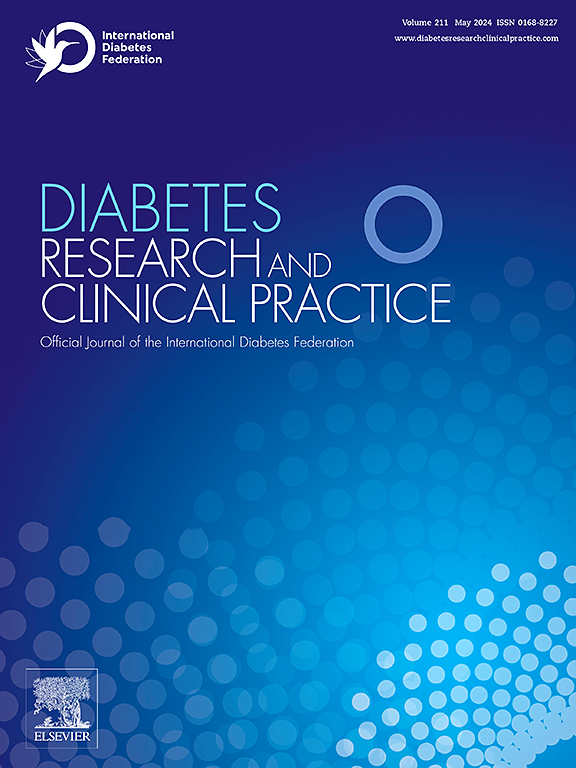基于真实世界电子病历数据识别中国 2 型糖尿病亚型。
IF 6.1
3区 医学
Q1 ENDOCRINOLOGY & METABOLISM
引用次数: 0
摘要
目的:在中国糖尿病人群中复制欧洲2型糖尿病(T2DM)亚型,并研究不同亚型的并发症风险:方法: 利用真实世界的患者数据构建糖尿病队列,并采用聚类方法对T2DM患者进行分组。方法:利用真实世界的患者数据构建糖尿病队列,并采用聚类方法对 T2DM 患者进行分组,采用 Kaplan-Meier 分析和 Cox 模型分析糖尿病亚型与并发症风险之间的关系:共提取了 2,652 名 T2DM 患者的完整聚类数据。其中,466人(17.57%)被归类为严重胰岛素缺乏性糖尿病(SIDD),502人(18.93%)被归类为严重胰岛素抵抗性糖尿病(SIRD),672人(25.34%)被归类为轻度肥胖相关性糖尿病(MOD),1 012人(38.16%)被归类为轻度年龄相关性糖尿病(MARD)。四个亚型的慢性肾脏病(CKD)和糖尿病视网膜病变(DR)风险不同。与 MARD 相比,SIRD 罹患 CKD 的风险更高(HR 2.01 [1.03, 3.91]),SIDD 罹患 DR 的风险更高(HR 2.17 [1.12, 4.20])。中风和冠状动脉事件的风险没有差异:结论:欧洲 T2DM 亚型可在中国糖尿病人群中复制。结论:欧洲的 T2DM 亚型可在中国糖尿病人群中复制,不同亚型发生 CKD 和 DR 的风险不同,这表明可以采取适当的干预措施来预防不同亚型的特定并发症。本文章由计算机程序翻译,如有差异,请以英文原文为准。
Identifying subtypes of type 2 diabetes mellitus based on real-world electronic medical record data in China
Aims
To replicate the European subtypes of type 2 diabetes mellitus (T2DM) in the Chinese diabetes population and investigate the risk of complications in different subtypes.
Methods
A diabetes cohort using real-world patient data was constructed, and clustering was employed to subgroup the T2DM patients. Kaplan–Meier analysis and the Cox models were used to analyze the association between diabetes subtypes and the risk of complications.
Results
A total of 2,652 T2DM patients with complete clustering data were extracted. Among them, 466 (17.57 %) were classified as severe insulin-deficient diabetes (SIDD), 502 (18.93 %) as severe insulin-resistant diabetes (SIRD), 672 (25.34 %) as mild obesity-related diabetes (MOD), and 1,012 (38.16 %) as mild age-related diabetes (MARD). The risk of chronic kidney disease (CKD) and diabetic retinopathy (DR) were different in the four subtypes. Compared with MARD, SIRD had a higher risk of CKD (HR 2.40 [1.16, 4.96]), and SIDD had a higher risk of DR (HR 2.16 [1.11, 4.20]). The risk of stroke and coronary events had no difference.
Conclusions
The European T2DM subtypes can be replicated in the Chinese diabetes population. The risk of CKD and DR varied among different subtypes, indicating that proper interventions can be taken to prevent specific complications in different subtypes.
求助全文
通过发布文献求助,成功后即可免费获取论文全文。
去求助
来源期刊

Diabetes research and clinical practice
医学-内分泌学与代谢
CiteScore
10.30
自引率
3.90%
发文量
862
审稿时长
32 days
期刊介绍:
Diabetes Research and Clinical Practice is an international journal for health-care providers and clinically oriented researchers that publishes high-quality original research articles and expert reviews in diabetes and related areas. The role of the journal is to provide a venue for dissemination of knowledge and discussion of topics related to diabetes clinical research and patient care. Topics of focus include translational science, genetics, immunology, nutrition, psychosocial research, epidemiology, prevention, socio-economic research, complications, new treatments, technologies and therapy.
 求助内容:
求助内容: 应助结果提醒方式:
应助结果提醒方式:


